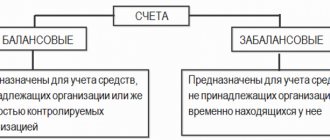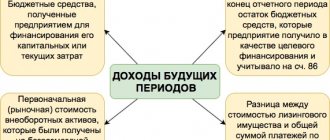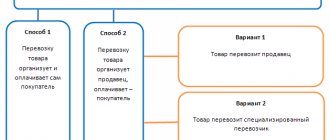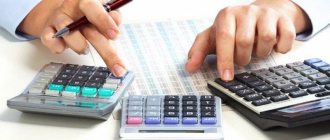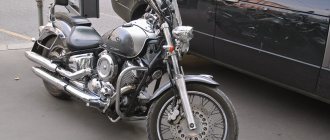What are the features of concluding a contract (agreement) for the supply of auto parts? How are spare parts purchased for a fee, as well as those obtained as a result of dismantling, liquidation and repair of vehicles, reflected in accounting? In what cases should auto parts be included on the balance sheet?
In the modern world, a car has long ceased to be a luxury, turning into a necessary means of transportation. Therefore, the issues of accounting for the costs of maintaining it in a condition suitable for operation are always relevant. In this article we will talk about the acquisition and accounting of spare parts intended for repair and replacement of worn-out car parts.
- 1 Features of concluding a contract (agreement) for the supply of auto parts
- 2 Accounting for auto parts in accounting (budget) accounting
- 3 Acceptance for accounting of spare parts obtained as a result of disassembly, recycling (liquidation), and repair of vehicles.
- 4 Installation of spare parts for transport
Off-balance sheet account 09 in budget accounting
Spare parts accounting often raises questions among users of 1C programs. In this article I will describe an example of reflection in 1C: Accounting of a government agency 8th edition. 1.0 purchasing a spare part, installing it on a vehicle and deregistering it as a result of failure.
According to clause 349 of Instruction No. 157n, off-balance sheet account 09 “Spare parts for vehicles issued in replacement of worn-out ones” takes into account material assets issued for vehicles in replacement of worn-out ones (filters, batteries, tires, engines, etc.) for control purposes their use. The first document that we will enter in our example is “Purchase of materials”. You can read more about inventory accounting in the article Procedure for filling out materials accounting documents in “1C: Accounting of a government institution, 8th ed. 1.0"
First, the spare part is registered on account 105.00 and remains there until it is installed on the vehicle. At the time of installation of this spare part on the vehicle, it is necessary to enter the document “Write-off of materials” with the type of operation “Write-off of spare parts for vehicles (receipt to off-balance sheet account 09)”.
When installing spare parts, we assign them to account 09 (spare parts for vehicles issued to replace worn-out ones), and they remain there until they fail and are written off from the register.
When writing off, we indicate the vehicle on which the spare part is installed.
Postings generated by the document “Write-off of materials”:
After this spare part on the vehicle fails, it will need to be written off from account 09. To do this, create a document “Write-off of materials (off-balance sheet accounting)”, located in the menu “Material inventories” - “Materials on off-balance sheet accounts”.
After posting this document, a credit entry for account 09 was generated.
The wiring was formed one-sided, because 09 account is off-balance sheet. According to clause 349 of Instruction No. 157n, the write-off of material assets from off-balance sheet account 09 is carried out on the basis of an acceptance certificate for completed work, confirming their replacement. Therefore, as a printed form for the document “Write-off of materials (off-balance sheet accounting)”, you can generate a Certificate (f. 0504833).
If you need more information about working in 1C: BGU 8, then you can get our collection of articles for free using the link.
Author of the article: Natalya Stakhneva
Consultant on 1C programs for government agencies
Did you like the article? Subscribe to the newsletter for new materials
When is it impossible to transfer property from off-balance sheet accounts 03 and 07?
The answer is obvious - when it does not satisfy at least one of the conditions listed above.
Let's take a closer look at examples.
Example 1. In the accounting of the institution, fuel cards are taken into account in off-balance sheet account 03 in accordance with the provisions of the accounting policy. There is no need to transfer them from off-balance sheet account 03 to the balance sheet as part of material inventories. The fact is that fuel cards, as a rule, are the property of the company that issued them. Accordingly, they do not satisfy the concept of an asset.
More on the topic: Accounting for several operating leases received under a single agreement
Example 2. In the accounting of the institution on off-balance sheet account 07, certificates acquired in 2014-2015 are taken into account. The institution does not have a warehouse. The certificates are kept by the employees responsible for issuing them. In this case, there is no need to transfer certificates from off-balance sheet account 07 to balance sheet account 105 06.
General accounting procedure for off-balance sheet accounts
The list of standard off-balance sheet accounts was approved by Order of the Ministry of Finance of Russia dated December 1, 2010 No. 157n: numbered from 1 to 27, as well as 29, 30, 31, 40 and 42.
A simple accounting scheme is applied to all off-balance sheet accounts, that is, income is reflected only as a debit, and expenses - as a credit, without correspondence.
Data on off-balance sheet accounts does not have to be reflected in the journals of transactions and in the General Ledger.
All material assets, as well as other assets and liabilities recorded on off-balance sheet accounts, are inventoried in the manner and within the time limits established for objects recorded on the balance sheet.
Common mistakes made by public sector employees when doing accounting
Error 1. New tires, which were purchased as spare parts, separately from the car, to replace worn-out (unsuitable) ones, are taken into account exclusively among other mats. stocks. Contrary to erroneous opinion, they simply cannot be taken into account as the main means. And their service life does not decide anything here. Actually, changing one part for another is regarded here as vehicle repair.
If worn-out tires can still be repaired, then the cost of repair work is included in expenses, displaying: DT 1 401 01 225 “Maintenance expenses”, 2 106 04 340 “Increase in manufacturing price” KT 1 (2) 302 08 730 “Increase in accounts payable according to calculations.”
Property accounting
Property is accounted for in 14 off-balance sheet accounts: 01, 02, 05, 06, 07, 09, 12, 13, 21, 22, 24, 25, 26, 27:
- Account 01 “Property received for use.” The account takes into account property received by the institution for use, but these are not rental objects. These are values that, in accordance with the legislation of the Russian Federation, are not subject to reflection on the balance sheet of the institution: museum objects and museum collections included in the state part of the Museum Fund of the Russian Federation, non-exclusive rights to use the results of intellectual activity, rights to limited use of other people's land plots. Property is registered on the basis of an acceptance certificate or other document that confirms receipt of the property and rights to it. Property must be reflected at the cost indicated in the transfer and acceptance certificate. Accounting is carried out in the context of property objects, owners (balance holders) of property, as well as by inventory, serial, register numbers specified in the transfer and acceptance certificate or other document.
- Account 02 “Material assets accepted for storage.” It is here that it is now necessary to take into account the material assets of the institution that do not meet the criteria of assets, as well as property in respect of which a decision has been made to be written off until it is dismantled, disposed of, or destroyed. Material assets accepted by an institution for storage and processing are accounted for on the basis of a primary document that confirms their receipt: an acceptance certificate, a contract, etc. Objects are reflected at the cost indicated in the primary document. If the institution executed the deed unilaterally - according to the conditional valuation: one object - 1 ruble. The disposal of MC from off-balance sheet accounting is reflected on the basis of supporting documents at the cost at which they were accepted for off-balance sheet accounting.
Write-off of MBP in 1C 8.3
IBP includes assets with a service life of no more than 1 year and a cost of less than 40,000 rubles, if the accounting regulations stipulate that such assets are reflected as part of the IBP. Currently, the concept of “SME” is not used in legislation, and such assets are accounted for in account 10.09 “Inventory and household supplies.”
More details Accounting policy designer
Let's look at how to write off an IBP in 1C 8.3 Accounting using the example of writing off (putting into operation) business equipment.
On June 06, 1 piece of business equipment was transferred to the Sales Department: Canon DR-C225W office scanner. materially responsible person, manager V.S. Komarov.
Document the transfer of materials for the needs of the organization, which must be taken into account on the balance sheet before they are actually written off, with the document Transfer of materials into operation in the section Warehouse - Workwear and equipment - Transfer of materials into operation.
On the Inventory and Household Supplies , indicate the materials transferred for operation, the materially responsible person (MRP) to whom they are assigned, and the method of accounting for costs.
Postings according to the document
The document generates transactions:
- Dt 44.01 Kt 10.09 - the cost of inventory is written off as distribution costs;
- MC.04 - the cost of inventory in operation is reflected off the balance sheet.
Learn more Write-off (transfer into operation) of business equipment as part of distribution costs
Accounting for strict reporting forms, vouchers, periodicals
The listed assets are recorded in off-balance sheet accounts: 03, 08, 23.
- Account 03 “Strict reporting forms”. The list of SSBs and the procedure for their evaluation (according to a conditional valuation - 1 ruble per form or acquisition cost) is established in the accounting policy. Records are kept in the book of strict reporting forms for each type of form, broken down by responsible persons and storage locations. Forms are written off on the basis of an acceptance certificate or a write-off act in cases of issuance of BSO, transfer to another organization or damage, theft, shortage.
- Account 08 “Unpaid vouchers.” Vouchers are accepted for accounting when stored at the cash desk at the nominal value indicated on the voucher form or in the conditional valuation in the absence of a nominal value. Accounting is carried out in a quantitative and total accounting card for responsible persons, storage locations, types of vouchers and cost.
- Account 23 “Periodicals for use.” Acceptance for accounting is carried out on a conditional basis. Analytical accounting is maintained in a quantitative accounting card for each periodical. Write-off of accounting objects is carried out by decision of the commission on the basis of an act.
Organization of the accounting process.
In order to organize the accounting process for the operation of car tires, institutions should develop the necessary internal administrative documents establishing, in particular:
- forms of primary documents for acceptance, release, internal movement, write-off of tires and the procedure for filling them out, as well as document flow rules;
- the procedure for monitoring the rational use of tires;
- list of officials responsible for receiving and issuing tires.
When developing relevant documents, it is necessary to take into account the following provisions:
- Rules for the operation of automobile tires (AE 001‑04), approved by Order of the Ministry of Transport of the Russian Federation dated January 21, 2004 No. AK-9‑r (hereinafter referred to as Rules No. AE 001‑04), which can be followed to this day (see Letter from the Ministry of Justice of the Russian Federation dated 09/21/2009 No. 03‑2609);
- Temporary norms for the operational mileage of tires of motor vehicles (RD 3112199‑1085‑02), approved by the Ministry of Transport of the Russian Federation on 04.04.2002, which provides data on the average mileage of tires of various types of vehicles, as well as a formula for calculating the norm of operational mileage.
Please note that only when the service mileage has been reached, tires must be replaced or written off from the register. To track such mileage, as well as the technical condition of the tire, you should create a card to record its operation. The institution has the right to develop the form of this document independently or use the one given in Appendix 12 to Rules No. AE 001-04.
For a sample of the recommended form of a car tire performance record card (new, retreaded, resurfaced, used), see the end of the article.
These cards serve as the basis for the formation of primary accounting documents on the movement of car tires in the institution and the corresponding entries in the accounting accounts.
Accounting for money, settlements and settlement documents
Money, settlements and settlement documents are taken into account from the 14th to the 19th and on the 30th off-balance sheet accounts.
- Account 14 “Settlement documents awaiting execution” and account 15 “Settlement documents not paid on time due to lack of funds in the account of a state (municipal) institution).” Accounting for settlement documents is maintained in the accounting card for settlement documents awaiting execution, broken down by accounts for each document.
- Account 16 “Overpayments of pensions and benefits due to incorrect application of legislation on pensions and benefits, accounting errors.” Keep records in the Funds and Settlements Accounting Card. Registration is carried out on the basis of audit reports, inspections and other similar documents. In account 16, the amounts of overpaid benefits continue to be recorded until they are fully repaid or written off. If repayment or collection occurs over a period of several months, amounts held off balance may also be written off gradually.
- Account 17 “Cash receipts” and account 18 “Cash outflows”. Accounts must be opened for balance sheet accounts: 201.00 “Cash of the institution”, 210.03 “Settlements with the financial authority for cash” and 304.06 “Settlements with other creditors” (in terms of cash settlements). Accounting is carried out in a multi-graph card or a card for recording funds and settlements in the context of institution accounts, by type of disposals and receipts (in the context of KOSGU). At the end of the year, account balances are not carried over to the next year. Thus, accounts 17 and 18 must be closed as of December 31 of the reporting year.
- Account 19 “Unexplained receipts from previous years.” Accounting is carried out according to the dates of crediting of uncleared receipts and the dates of their clarification.
- Account 30 “Settlements for the fulfillment of monetary obligations through third parties.” Analytical accounting of the account is maintained in a multigraph card and (or) in a card for accounting for funds and settlements in the context of monetary obligations by type of payment of budget funds or other types of payments.
Features for budgetary institutions
The use of off-balance sheets in the accounting of a budgetary institution is regulated by Instruction 157n (section 7). This section provides a list of assets that should not be included in balance sheet accounts. According to current legislation, institutions have the right to adjust this list and, if necessary, include other inventory items in it.
In accordance with paragraph 373 of Instruction 157n as amended on March 31, 2018, accounting is carried out on off-balance sheet accounts of budgetary institutions:
- valuables located in the organization without the right of operational management (rent, free use, etc.);
- valuables that are taken into account outside balance sheet accounts (fixed assets in the amount of up to 10,000 rubles, strict reporting forms, prizes, vouchers, etc.);
- obligations awaiting fulfillment.
You can familiarize yourself with all the accounts that are used when maintaining records in a budgetary institution in the table.
| No. ZSCh | Name |
| 01 | "Property received for use" |
| 02 | “Material assets accepted for storage” |
| 03 | "Strict reporting forms" |
| 04 | "Debt of insolvent debtors" |
| 05 | “Material assets paid for through centralized supply” |
| 06 | “Debt of pupils and students for unreturned material assets” |
| 07 | “Awards, prizes, cups and valuable gifts, souvenirs” |
| 08 | "Vouchers unpaid" |
| 09 | "Spare parts for vehicles" |
| 10 | “Ensuring the fulfillment of obligations” |
| 11 | "State municipal guarantees" |
| 12 | “Special equipment for carrying out research work under contracts by customers” |
| 13 | "Experimental Devices" |
| 14 | "Settlement documents awaiting execution" |
| 15 | “Settlement documents not paid on time due to lack of funds in the account of a state (municipal) institution” |
| 16 | “Overpayments of pensions and benefits due to incorrect application of legislation on pensions and benefits, accounting errors” |
| 17 | "Cash receipts" |
| 18 | "Cash Outflows" |
| 19 | “Unexplained budget revenues from previous years” |
| 20 | "Debt unclaimed by creditors" |
| 21 | “OS worth up to 10,000 rubles inclusive in operation” |
| 22 | “Material assets received through centralized supply” |
| 23 | "Periodicals for use" |
| 24 | “Property transferred into trust management” |
| 25 | “Property transferred for paid use (rent)” |
| 26 | “Property transferred for free use” |
| 27 | “Material assets issued for personal use to employees (employees)” |
| 30 | “Calculations for the fulfillment of monetary obligations through third parties” |
| 31 | "Shares at par value" |
| 40 | "Assets in management companies" |
| 42 | “Budget investments implemented by organizations” |
Accounting for receivables and payables
To account for receivables and payables on the off-balance sheet, two accounts are provided: account 04 “Debt of insolvent debtors” and account 20 “Debt unclaimed by creditors”.
Debt is reflected in accounting at the moment when the commission for the receipt and disposal of assets makes a decision to write it off from the balance sheet.
Debt accounting is maintained in the card for accounting for funds and settlements:
- by type of revenue and debtor for accounts receivable;
- by types of payments and receipts and by creditors for accounts payable.
From account 04, the debt is written off by decision of the commission (in the event of death or liquidation of the debtor), when the debt collection procedure is resumed, or if money has been deposited into the account to repay the debt.
Write-off of tires that cannot be repaired
Tires are subject to write-off and subsequent disposal only when they have become completely unusable and for this reason their further operation is not possible. Whether they can actually be used or not, especially in the presence of specific damage, is determined taking into account the applicable operating standards. For example, the tread depth turns out to be higher than permissible, which is not the norm. Therefore, the part is not allowed for use.
Unusable tires are replaced, and all related operations are displayed in the established order. Typically, write-off is carried out by decision of the authorized special commission of the institution. In this case, everything is drawn up in accordance with the directives of the accounting policy.
The fact of write-off can be documented, for example, through a standard accounting system. certificate (OKUD 0504833), as well as a standard write-off act (OKUD 0504230). The movement of tires is displayed through their removal from the vehicle. sch. 09 and acceptance of those already written off as waste. sch. 02 at the price specified at write-off or conditionally 1 pc. – 1 rub.
Thus, when writing off tires, a budgetary institution should be guided by the settings of its accounting policies, Instructions No. 174n and 157n. By posting, state employees display the following:
- DT 0 105 36 340 CT 0 401 10 189 (receipt of tires that cannot be repaired on the day of their acceptance at the estimated price);
- DT 2 401 10 172 CT 2 105 36 440 (their scrapping is shown);
- DT 2 209 89 560 CT 2 401 10 172 (income from scrapping is shown).
For your information, public sector employees have the right to spend the money received from recycling as a profit-generating activity at their discretion. But at the same time, the possibility of carrying out this type of activity must be provided for in the constituent documentation. Grounds: clause 3 of Art. 298 Civil Code of the Russian Federation.
Accounting for guarantees
Accounting for guarantees is carried out on accounts 10 and 11.
- Account 10 “Ensuring the fulfillment of obligations.” Collaterals are accepted for accounting according to source documents in the amount of the obligation for which the collateral was received. Accounting is kept in a multigraph card in the context of obligations by type of property (collateral), its quantity, storage locations and obligations for which the property was received as security. The collateral is written off if obligations are fulfilled.
- Account 11 “State municipal guarantees”. Accounting is kept in the card for accounting funds and settlements in the context of subjects of civil rights and obligations for which guarantees are provided, by type and amount of guarantee. Collateral amounts are debited from the account when the obligations in respect of which the guarantee was provided are fulfilled.
Accounting for financial investments
- Account 31 “Shares at par value”. Accounting is maintained by a body with the powers of a shareholder or another authorized body. Shares are placed on off-balance sheet accounting simultaneously with their reflection in account 204.30 “Shares and other forms of participation in capital.” Accounting is maintained in the securities register.
- Account 40 “Assets in management companies.” The off-balance sheet takes into account assets that are listed in account 204.51 “Assets in management companies.” The value of the property is adjusted at the reporting date. Accounting is carried out by groups and types of non-financial and financial assets.
- Account 42 “Budget investments implemented by organizations.” Acceptance for accounting occurs based on data on the transfer of funds or transfer of assets. Investments are written off from the balance sheet upon completion of work and commissioning of capital construction projects. Analytical accounting of the account is carried out by recipients of funds.
Additional off-balance sheet accounts
The Ministry of Finance reserved for budgetary institutions the right to introduce additional off-balance sheet accounts necessary for collecting information and monitoring property. To do this, it is enough to fix the accounting procedure for off-balance sheet accounts in the accounting policy. But it should be noted that the numbering of additional off-balance sheet accounts should not conflict with the numbering of accounts assigned by the Ministry of Finance. To do this, it is best to assign a three-digit or letter code to additional off-balance sheet accounts (for example, 100, 101, TR, etc.).
Accounting for spare parts for cars
Auto parts become the property of organizations in several ways:
- purchased for the appropriate payment: cash or non-cash payment;
- may be revealed as a result of the internal dynamics of fixed assets: disassembly, repair work, disposal of some part of the fleet;
- can be manufactured or adapted to work in-house by the enterprise.
IMPORTANT! A sample record sheet for consumables and spare parts from ConsultantPlus is available here
Each type of reflection of spare parts intended for the repair and replacement of worn-out parts in vehicles should be taken into account in accounting in its own way.
To do this, a special order of the organization should be issued, which will stipulate the following key points:
- List of spare parts that can be issued from the warehouse for internal use according to a document signed by a senior executive.
- Regulations for taking spare parts from the warehouse for sale.
- Formation of a reserve of spare parts according to the approved list.
Reflection of purchased spare parts
Automotive parts purchased from a supplier, no matter in what quantity and for what amount, are essentially inventories. The same applies to products manufactured at the enterprise, including components and assemblies for cars. This is how they need to be carried out according to accounting from entry to write-off. For this PBU, a special sub-account is provided for account 10 “Materials”, namely 10.5 “Spare parts”. Order:
- Registration of newly received spare parts. The documents reflect the actual cost of purchased or manufactured parts, that is, the amount that was spent to make them available. VAT and other taxes are not included.
- Posting. To account for spare parts in 1-C, there is a special program in which their technical characteristics need to be reflected. This is necessary in order not to confuse one part with another: after all, there are many spare parts with similar names.
NOTE! Accounts in correspondence to the main account can be, depending on the method of acquisition, accounts 60 “Settlements with suppliers and contractors”, 76 “Settlements with various debtors and creditors”, 71 “Settlements with accountable persons”.
EXAMPLE OF WIRING . Let’s imagine that Transmagistral LLC purchased a new battery for a passenger car from a supplier for replacement. The wiring will look like this:
- debit 10.5, credit 60 – amount paid for the purchase of a car battery;
- debit 19 “VAT”, credit 60 – reflection of the supplier’s VAT;
- debit 68 “Calculations for taxes and fees”, credit 19 – presentation of VAT for deduction.
Accounting for spare parts received from disassembly
From time to time, the useful life of any fixed asset comes to an end, transport is no exception. In addition, the machine may become unsuitable for further use after an accident. If the repair turns out to be impractical, the car will be written off, after having previously removed all parts that may be useful, as well as material suitable for scrap metal. All this needs to be put into accounting. This happens on the date when the vehicle was written off. All remaining costs that are not included in the results of dismantling are written off under credit 91.1 “Other expenses.”
Accounts that reflect the cost of removed materials may be as follows:
- debit 10, subaccount 10.5 “Spare parts” - for those parts that are intended to be used within the enterprise;
- debit 10, subaccount 10.6 “Other materials” - for those materials that this organization is not authorized to use, but they are suitable for recycling (metal, scrap).
ATTENTION! The cost of spare parts reflected in these accounts is determined as the current market value on the date of registration, that is, the price that would be given for them if they were sold right today. For convenience, it is customary to use the same figures as for tax accounting.
EXAMPLE OF WIRING. As a result of the write-off of the old truck, the company was left with parts and materials in the amount determined by the commission. Wiring:
- debit 10.5, credit 91.1 – capitalization of spare parts for further use.
Accounting for spare parts remaining after repairs
Sometimes, in the process of repairing a vehicle fleet, working spare parts are replaced with new ones for modernization, tuning is performed, etc. The removed parts are still serviceable or subject to repair, and they also need to be registered. The posting will be the same as in the case of materials from car disposal: debit 105, credit 91. As for the cost reflected on the balance sheet, it will not change depending on the condition of the part:
- if the spare part is in order, it is accepted at the current market value;
- if they decide to repair it, then the costs for this will simply be written off from the current month;
- in those rare cases when the decision to repair and its implementation is made immediately, the cost of the part will be increased by repair costs plus the cost of delivery to a car service center.
Accounting for spare parts release
When spare parts are put into use - no matter whether they are sold or put into operation, you need to correctly assess their cost. To do this, you need to determine in the accounting policy which method will be adopted by the company:
- the cost of each part is taken into account separately;
- average cost of spare parts;
- FIFO method - reflection of cost in the order in which spare parts are received on the balance sheet, the so-called “first to come, first to leave.”
IMPORTANT INFORMATION! Whatever the method is enshrined in the company’s regulations, if the spare parts are dissimilar and cannot replace each other, they must be assessed each at their own cost.
Spare parts are written off for use in the debit of account 20 “Main production” or “Auxiliary production”.
EXAMPLE OF WIRING. There are several similar automotive gearboxes in stock. They arrived at different times, so their prices are different. One of them is taken away for use in the main production. Depending on the chosen policy, the write-off cost may be:
- the same as she was upon admission;
- average of the cost of all available gearboxes;
- the same as the first gearbox that arrived.
Wiring:
- debit 20, credit 10.5 – reflects the cost of the decommissioned gearbox.
Final write-off of spare parts
If further use of the removed spare part is no longer possible, and its repair is impractical, it must be written off irrevocably. However, it still has some material value: the price of scrap (salvage). The organization delivers metal or raw materials to specialized points, receiving a certain amount of money for it. These funds need to be capitalized.
EXAMPLE OF WIRING. An old car destroyed in an accident cannot be repaired. The company handed it over to a scrap metal collection point. An assessment was made, and a certain value of scrap metal was credited to the company’s account, which will coincide with the current value of the car being written off. The wiring will look like this:
- debit 10.5 “Spare parts”, credit 91.1 “Other expenses” - capitalization of metal parts of a car (at the price of scrap);
- debit 62 “Settlements with buyers and customers”, credit 91.1 “Other income” - reflection of the sale of scrap metal;
- debit 91.2, credit 10.5 – the cost of scrap metal is written off.
